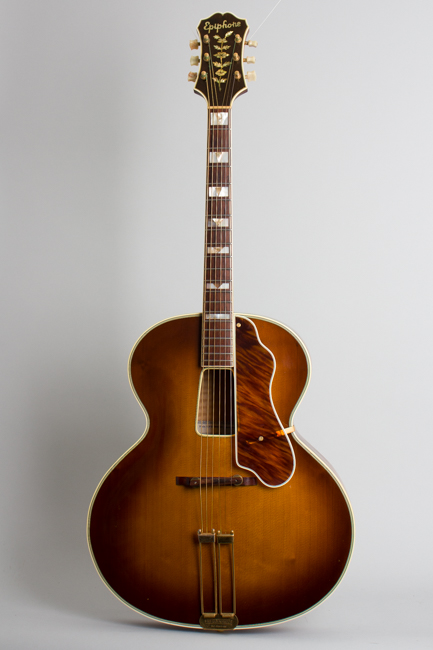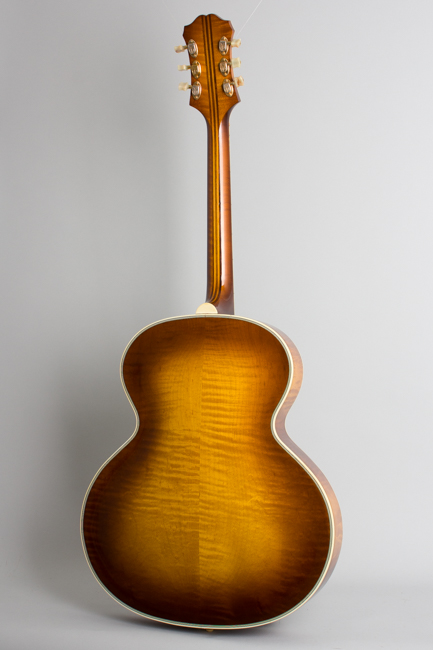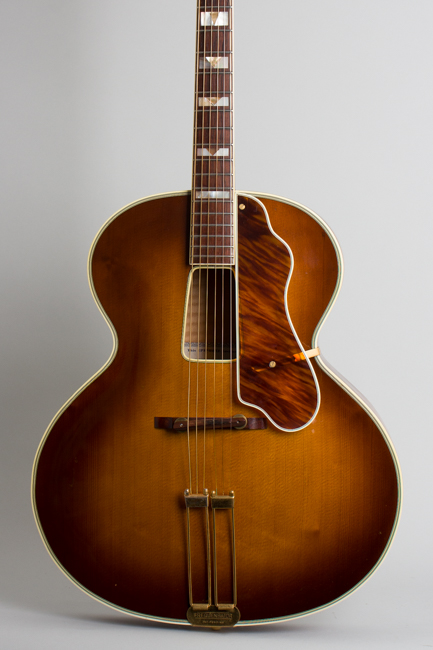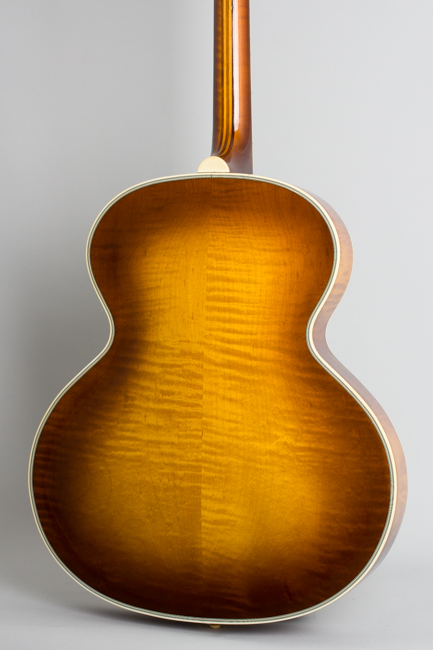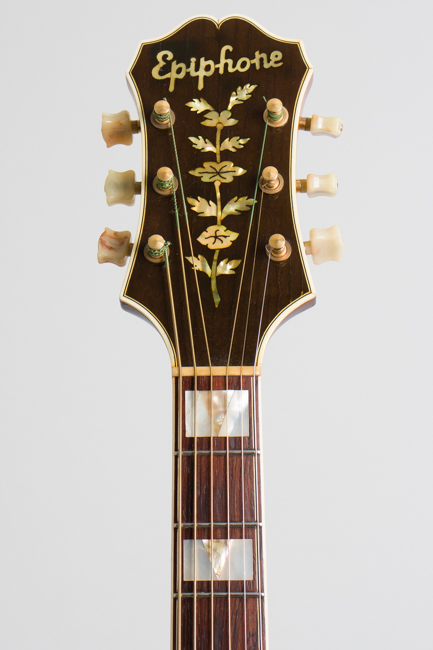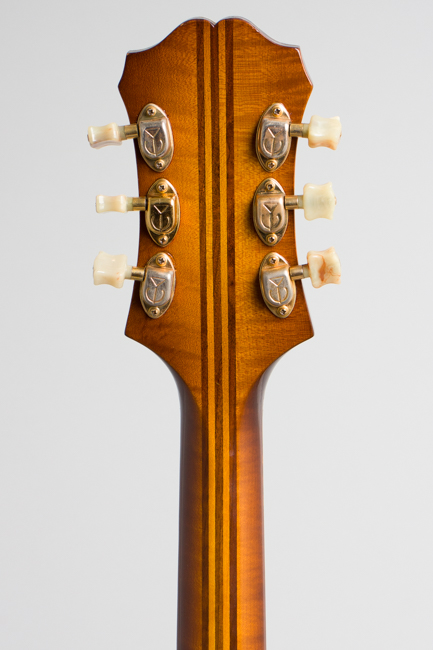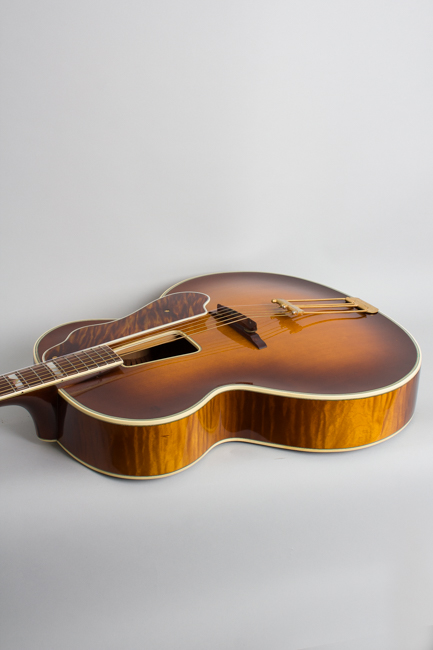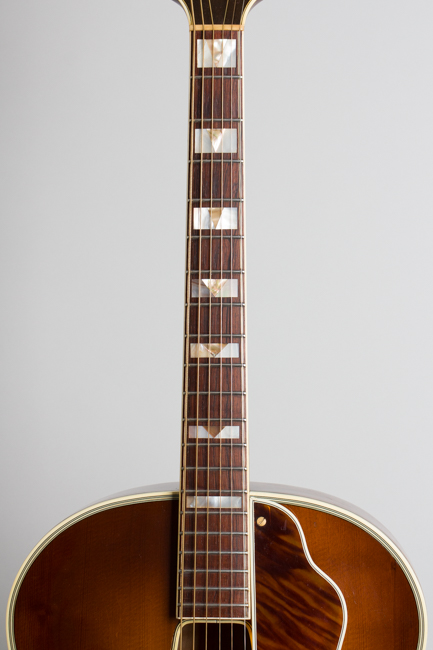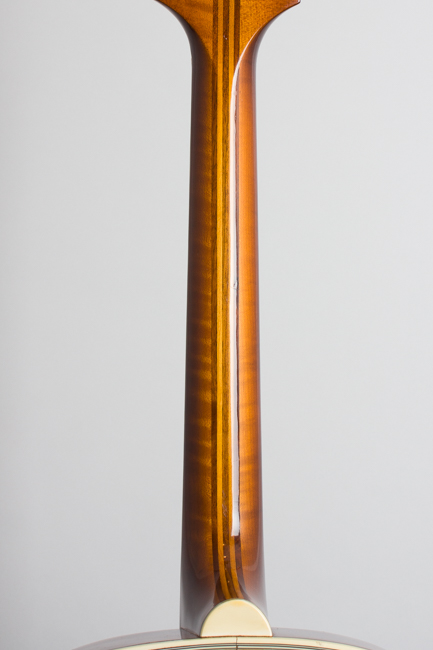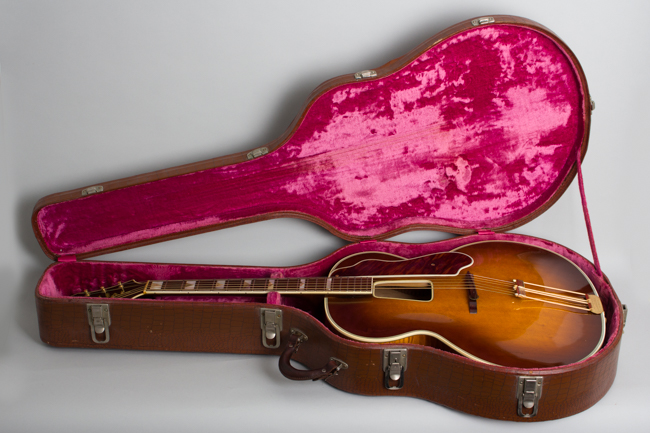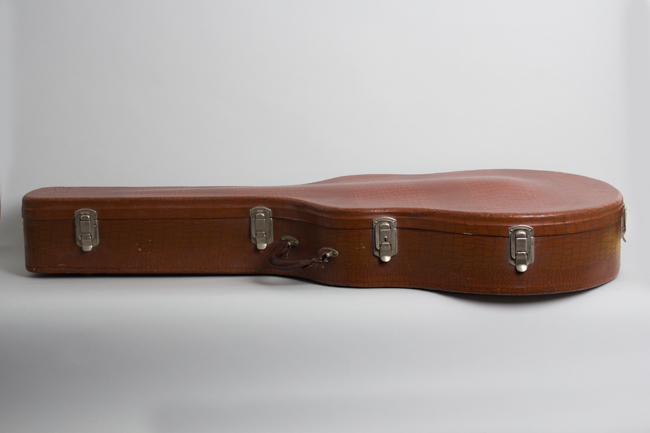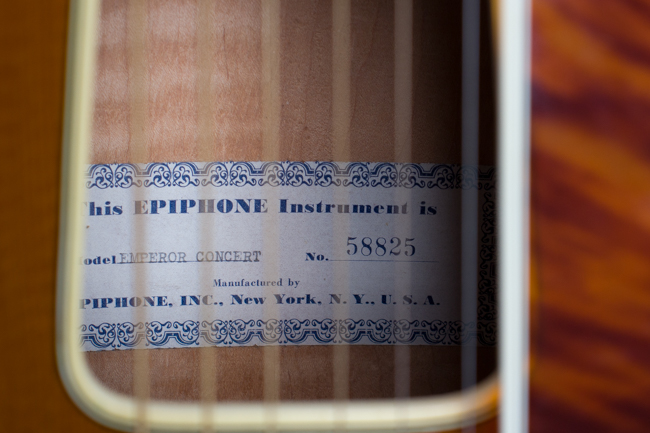Epiphone Emperor Concert Arch Top Acoustic Guitar (1949)
This item has been sold.
Item # 11335
Prices subject to change without notice.
Epiphone Emperor Concert Model Arch Top Acoustic Guitar (1949), made in New York, NY, serial # 58825, sunburst lacquer finish, maple back and sides, spruce top; laminated maple neck with rosewood fingerboard, original brown hard shell case.
This is an amazingly well preserved, truly lovely example of a unique and exceptionally rare version of the Epiphone Emperor, the New York company's top of the line instrument. At the time this guitar was made, the originally Epiphone company was about to enter a long decline but remained capable of the finest work. This is one of *three* known examples of this "Emperor Concert" model, distinguished primarily by the eccentric soundhole in the center of the top in place of the standard f-holes. It was developed with input from Johnny Smith, who in 1948 was a known pro player but not yet a major name. Already Smith had well-formed specific ideas about what he wanted in a guitar, and Epiphone was willing to indulge him.
Smith's concept was to use a central soundhole in a large-body archtop, a design dating to the 1910s but essentially abandoned by the mid-1930s. He tried working with Gretsch but the Synchromatic model built to his specs proved problematic. He brought the idea to Epiphone around 1947; the Epiphone Emperor Concert (and an apparently never produced Deluxe Concert model) appeared only on the company's March 15, 1948 pricelist alongside new cutaway models, but hardly any were produced. Only three are known to exist: Johnny Smith's personal guitar (with a later D'Angelico neck), a blonde example belonging to an ex-employee and this, the only sunburst one.
The unusual trapezoidal soundhole is the instrument's defining feature; it is eccentric in appearance but entirely practical as it does not interfere with the parallel bracing pattern. This makes for a smoother solo instrument than the standard F-hole construction, as Smith intended. He also suggested the bracing angle should be widened in the lower bout and the top carved thinner around the sound hole. There are subtle variations in the body dimensions from the standard Emperor as well. The Concert was intended to combine the considerable volume of the largest Epiphones with a warmer tone for Smith's particular blend of mellow but harmonically sophisticated "chamber jazz". He used his for some time but eventually decided it was too large, moving on to D'Angelico instruments then to a Guild and finally Gibson endorsement.
As with all Emperors this 18 2/2" beauty is heavily multi-bound with a carved spruce top over solid flame maple back and sides. The 25 1/2" scale neck is 7-ply multi-laminate maple with a heavily decorated rosewood fingerboard sporting the trademark split block inlay and first pattern adjustable truss rod. It is slimmer at the nut than many Emperors. The fancy multi bound headstock is faced with Epiphone's "Tree of Life" inlay and mounts their in-house gold plated tuners. The guitar has a gold Frequensator tailpiece, which is equipped with two long tines (the short one is in the case pocket); interestingly this was Johnny Smith's preferred setup.
Many vintage guitars are relatively rare, but this Emperor Concert is genuinely unique. This is the only sunburst example that has ever been found of the three known to have been built. It survives in almost miraculously fine condition, an exceptional playing and sounding instrument with a tonal character unlike any archtop we have ever heard. Powerful, deep and sweet yet with the characteristic Epiphone punch when pushed, this is simply a spectacular find in every way.
Overall length is 43 1/2 in. (110.5 cm.), 18 5/8 in. (47.3 cm.) wide at lower bout, and 3 3/8 in. (8.6 cm.) in depth, measured at side of rim. Scale length is 25 1/2 in. (648 mm.). Width of nut is 1 5/8 in. (41 mm.).
This is an exceptionally clean and original guitar, especially amazing considering its unique character. The all-original finish shows very minor checking and handling wear with some tiny dings and dents, but really hardly any play wear at all. This guitar simply appears to have sat unused for most of its 70+ year life, which is kind of a shame for such a great sounding instrument but wonderful for us now well into the 21st century. It is also entirely free of the ageing issues that plague many old New York area instruments; the binding is fully intact with only the most minimal shrinkage and no celluloid deterioration at all.
The only alteration visible is a tiny filled hole on the bass side of the fingerboard extension, indicating some sort of pickup was once mounted there. The celluloid pickguard appears to be an original Epiphone piece but is the style used on a standard Emperor; the two other known "Concert" models have a unique shape opened slightly for the soundhole. Oddly enough, a later Emperor known to have belonged to Bucky Pizarelli is fitted with what appears to be an original Concert pattern pickguard, so perhaps these were switched at some point! It is also possible that Epiphone simply fitted this guitar with a standard pickguard at birth.
The original frets show some light wear (mostly along the B string) but nothing that affects playability. The neck angle is excellent; there is some very slight gapping at the heel, but the neck is not moving at all. This is simply a spectacular instrument in every way, both in sound and playing character among the very finest carved-top instruments we have ever seen (and heard). It still resides in the original brown HSC, also in excellent condition with a later handle. Overall Excellent + Condition.
This is an amazingly well preserved, truly lovely example of a unique and exceptionally rare version of the Epiphone Emperor, the New York company's top of the line instrument. At the time this guitar was made, the originally Epiphone company was about to enter a long decline but remained capable of the finest work. This is one of *three* known examples of this "Emperor Concert" model, distinguished primarily by the eccentric soundhole in the center of the top in place of the standard f-holes. It was developed with input from Johnny Smith, who in 1948 was a known pro player but not yet a major name. Already Smith had well-formed specific ideas about what he wanted in a guitar, and Epiphone was willing to indulge him.
Smith's concept was to use a central soundhole in a large-body archtop, a design dating to the 1910s but essentially abandoned by the mid-1930s. He tried working with Gretsch but the Synchromatic model built to his specs proved problematic. He brought the idea to Epiphone around 1947; the Epiphone Emperor Concert (and an apparently never produced Deluxe Concert model) appeared only on the company's March 15, 1948 pricelist alongside new cutaway models, but hardly any were produced. Only three are known to exist: Johnny Smith's personal guitar (with a later D'Angelico neck), a blonde example belonging to an ex-employee and this, the only sunburst one.
The unusual trapezoidal soundhole is the instrument's defining feature; it is eccentric in appearance but entirely practical as it does not interfere with the parallel bracing pattern. This makes for a smoother solo instrument than the standard F-hole construction, as Smith intended. He also suggested the bracing angle should be widened in the lower bout and the top carved thinner around the sound hole. There are subtle variations in the body dimensions from the standard Emperor as well. The Concert was intended to combine the considerable volume of the largest Epiphones with a warmer tone for Smith's particular blend of mellow but harmonically sophisticated "chamber jazz". He used his for some time but eventually decided it was too large, moving on to D'Angelico instruments then to a Guild and finally Gibson endorsement.
As with all Emperors this 18 2/2" beauty is heavily multi-bound with a carved spruce top over solid flame maple back and sides. The 25 1/2" scale neck is 7-ply multi-laminate maple with a heavily decorated rosewood fingerboard sporting the trademark split block inlay and first pattern adjustable truss rod. It is slimmer at the nut than many Emperors. The fancy multi bound headstock is faced with Epiphone's "Tree of Life" inlay and mounts their in-house gold plated tuners. The guitar has a gold Frequensator tailpiece, which is equipped with two long tines (the short one is in the case pocket); interestingly this was Johnny Smith's preferred setup.
Many vintage guitars are relatively rare, but this Emperor Concert is genuinely unique. This is the only sunburst example that has ever been found of the three known to have been built. It survives in almost miraculously fine condition, an exceptional playing and sounding instrument with a tonal character unlike any archtop we have ever heard. Powerful, deep and sweet yet with the characteristic Epiphone punch when pushed, this is simply a spectacular find in every way.
Overall length is 43 1/2 in. (110.5 cm.), 18 5/8 in. (47.3 cm.) wide at lower bout, and 3 3/8 in. (8.6 cm.) in depth, measured at side of rim. Scale length is 25 1/2 in. (648 mm.). Width of nut is 1 5/8 in. (41 mm.).
This is an exceptionally clean and original guitar, especially amazing considering its unique character. The all-original finish shows very minor checking and handling wear with some tiny dings and dents, but really hardly any play wear at all. This guitar simply appears to have sat unused for most of its 70+ year life, which is kind of a shame for such a great sounding instrument but wonderful for us now well into the 21st century. It is also entirely free of the ageing issues that plague many old New York area instruments; the binding is fully intact with only the most minimal shrinkage and no celluloid deterioration at all.
The only alteration visible is a tiny filled hole on the bass side of the fingerboard extension, indicating some sort of pickup was once mounted there. The celluloid pickguard appears to be an original Epiphone piece but is the style used on a standard Emperor; the two other known "Concert" models have a unique shape opened slightly for the soundhole. Oddly enough, a later Emperor known to have belonged to Bucky Pizarelli is fitted with what appears to be an original Concert pattern pickguard, so perhaps these were switched at some point! It is also possible that Epiphone simply fitted this guitar with a standard pickguard at birth.
The original frets show some light wear (mostly along the B string) but nothing that affects playability. The neck angle is excellent; there is some very slight gapping at the heel, but the neck is not moving at all. This is simply a spectacular instrument in every way, both in sound and playing character among the very finest carved-top instruments we have ever seen (and heard). It still resides in the original brown HSC, also in excellent condition with a later handle. Overall Excellent + Condition.
